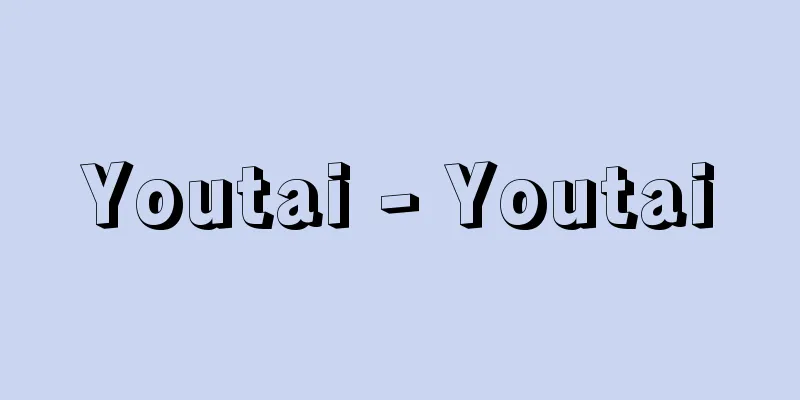Japan-US Security Treaty

|
Officially, it is the "Treaty of Mutual Cooperation and Security between Japan and the United States of America." It is also abbreviated as the "Security Treaty." It was signed on January 19, 1960, and came into force on June 23. In addition to the treaty, there is an agreement regarding the status of US armed forces (known as the Japan-US Status of Forces Agreement), exchanges of notes, and minutes of agreement, and many related domestic laws have been enacted to implement it, which together form the so-called Japan-US security system. The current treaty replaced the old Security Treaty (the "Treaty of Security between Japan and the United States of America," signed on September 8, 1951, and came into force on April 28, 1952) through the "Security Revision" of 1960. [Yasuo Ishimoto] Main contents of the Security TreatyThe main contents of the Security Treaty are as follows: (1) Article 6 allows the U.S. military to use facilities and areas in Japan, and Japan is obligated to provide them free of charge. The facilities and areas to be provided or returned are decided through discussions in the Japan-U.S. Joint Committee. The facilities to be provided by Japan for the maintenance of facilities and areas are specified in detail in the Status of Forces Agreement, but the scope is extremely broad. In particular, with regard to the provision of areas, there is the Special Measures Law for U.S. Military Lands Used by the U.S. Armed Forces, and in 1997 this law was amended to allow the continuation of use of U.S. military land in Okinawa even after the expiration of its usage period while the expropriation committee is deliberating. As of September 1999, the U.S. military forces in Japan consisted of 1,779 Army personnel, 6,329 Navy personnel, 18,770 Marine Corps personnel, and 13,743 Air Force personnel. (2) Article 6 stipulates that the purpose of providing bases to the U.S. forces is "to contribute to the security of Japan and to the maintenance of international peace and security in the Far East." Because the purpose of maintaining U.S. military bases is not limited to the defense of Japan but extends broadly to the maintenance of peace in the Far East, this provision is known as the "Far East Clause." (3) Article 3 stipulates that each country will maintain and develop its "respective capability to resist armed attack," and Article 5 further stipulates that in the event of an "armed attack against either party in territories under the administration of Japan," the two countries will "act to meet the common danger." This constitutes the so-called mutual defense system. In order to facilitate its operation, the two countries are to hold regular consultations (Article 4). For this purpose, there are the "Japan-U.S. Security Consultative Committee" (SCC, established in 1960, also known as "2+2"; successor to the earlier Japan-U.S. Security Council), the "Japan-U.S. Senior Security Officials Consultation" (SSC, established in 1967), the "Subcommittee on Japan-U.S. Defense Cooperation" (SDC, established in 1976), the "Special Action Committee on Facilities and Areas in Okinawa" (SACO, established in 1995), a temporary "Special Action Committee on Okinawa" (SACO), established in 1995, and the "Japan-U.S. Joint Committee on the Implementation of the Status of Forces Agreement" (JCC, established in 1960), which is also composed of members at the ministerial level. In addition, director-general-level "Japan-U.S. Equipment and Technology Regular Consultations" are held to promote Japan-U.S. cooperation on defense-related technologies. (4) The treaty stipulates that after 10 years have passed since it came into force, that is, after June 23, 1970, either country may give notice of termination, in which case the treaty will end one year after the notice is given. In fact, no notice of termination has been given to the present day, and this is called the automatic extension or automatic continuation of the Security Treaty. [Yasuo Ishimoto] Issues surrounding the Security TreatyThe main issues surrounding the Security Treaty are as follows: [Yasuo Ishimoto] Far East ClauseThe US military and bases in Japan form part of the military forces of the US Far East Strategy, with the General Headquarters of the Pacific Command (Hawaii) at its apex. The treaty also allows for its use not only for the defense of Japan, but also "to contribute to the maintenance of international peace and security in the Far East" (Article 6). The treaty does not define the scope of the Far East, but according to the unified interpretation by the government, it includes "areas north of the Philippines, and areas in Japan and the surrounding areas under the control of the Republic of Korea and Taiwan." However, actions "to contribute to the maintenance of peace and security in the Far East" can be taken not only when these areas are directly attacked, but also when they are threatened by events occurring in other regions, and such actions themselves are not limited to the Far East. Therefore, the Far East Clause has almost no function of substantially restricting the actions of the US military. [Yasuo Ishimoto] Prior consultation systemIn order to prevent the risk of the US military forces and bases in Japan being used for military operations undesirable to Japan itself, and the risk of nuclear weapons being brought into Japanese territory, the official documents exchanged at the same time as the conclusion of the treaty stipulate that "the use of facilities and areas in Japan as bases for combat operations conducted from Japan" and "any significant changes in the deployment of US forces in Japan or in the equipment of such forces" will be subject to prior consultation between Japan and the United States. However, the prior consultation is limited to "combat operations" and does not extend to supplies, movements, and withdrawals, and verification of the introduction of nuclear weapons is impossible, so the function of the prior consultation was originally limited. In fact, an analysis of US diplomatic documents made public in the mid-1990s confirmed that there was a secret agreement between Japan and the United States in 1960 that "prior consultations would not be held only when US forces in Japan were deployed in the event of a Korean emergency." Furthermore, the 1969 Sato-Nixon Joint Statement on the Reversion of Okinawa repeatedly emphasized that the maintenance of peace and security in the Far East was an inseparable element of Japan's security, and suggested that Japan would adopt a "positive" attitude in prior consultations. This is why criticism of the "deformation of security" was leveled. Despite the "Three Non-Nuclear Principles" that Japan has firmly maintained as its national policy, official U.S. documents also show that at that time the Japanese government tacitly approved of nuclear-weapon-equipped ships passing through its territorial waters. [Yasuo Ishimoto] Constitutional IssuesArticle 3 of the treaty requires both countries to "maintain and develop their respective capabilities to resist armed attack." The government has explained that this is "conditional on compliance with the provisions of the Constitution," so there is no question of unconstitutionality. However, the interpretation of the Constitution is divided among the public as to whether Article 9 of our Constitution even allows for the possession of so-called self-defense forces. Putting this aside, Article 5 of the treaty stipulates the obligation of mutual defense. Since the obligation of mutual defense arises only in the case of "an armed attack against either Japan or the United States in the territories under the administration of Japan" (a so-called Japanese emergency), the government has explained that this falls within the scope of the "right of individual self-defense" and does not violate Article 9 of the Constitution. However, U.S. military bases in Japan are not only used in the case of a "Japanese emergency." The U.S. military can use the bases for the "peace and security of the Far East." If we imagine a case in which Japan is attacked by a foreign country as a result of such actions, mutual defense will have to mean not joint action for the local defense of Japan, but rather joint action between Japan and the United States in the Far East strategy in the event of a so-called "Far East emergency." This is, in other words, an exercise of the "right of collective self-defense," which entails the serious problem of whether it is something that is not permitted by the Constitution. The stronger the military ties between Japan and the United States become, the more difficult it will be to explain the situation without the "right of collective self-defense." [Yasuo Ishimoto] Base IssueDisputes over U.S. military facilities and areas in Japan are generally referred to as the base issue, and have been major political and social issues from the days of the old Security Treaty to the present. There are a variety of issues, including threats to life due to the loss of farmland, fishing grounds, access rights, and water rights, the risk of accidental firing and crashing, concerns about the introduction of nuclear weapons, threats to life due to the docking of nuclear-powered vessels and the establishment of hospitals, crimes committed by U.S. military personnel and problems with public morals, noise pollution, radio interference, transportation of hazardous materials, air route restrictions, and even pressure on local finances. Needless to say, the base issue is particularly serious in Okinawa, where the concentration of bases is extremely high. The need to ease the base issue is the reason why the US-Japan Special Action Committee on Okinawa was temporarily established between Japan and the US after the September 1995 rape of a young girl by a US soldier in Okinawa (established in November 1995, final report in December 1996), why the government has often emphasized the promotion of Okinawa's "economy," why Okinawa and Kyushu were selected as the venue for the 2000 G8 summit, and why Shureimon Gate was chosen for the design of the new banknotes. Nevertheless, as long as the bases remain, there will be no end to difficult problems to solve, such as the issue of setting up a replacement facility following the return of the US Marine Corps Air Station Futenma (which Nago City Mayor Kishimoto Tateo announced in December 1999 that he would accept). [Yasuo Ishimoto] The Political Process of the Security SystemSince the old Security Treaty was concluded, the treaty has often been a political issue that divided the nation, which means that the security system has always contained political weaknesses. The development of the security system can be said to have been a process of perfecting the mutual defense system, but at the same time, it was also a process of responding to such political weaknesses. For example, the first was the 1960 revision of the security treaty, i.e. the conclusion of the new security treaty. Whereas the old security treaty was limited to providing for the right of use of Japanese bases by the US military, the new security treaty was the first to explicitly state a mutual defense system. However, on the other hand, in order to overcome the political weaknesses of the old security treaty, a prior consultation system was introduced, and the merits of the "revision" were touted as making it difficult for the US alone to use bases for combat operations or to bring in nuclear weapons. Whereas the old security treaty had no time limit, the new security treaty included a termination clause. This was also a response to public criticism. For this reason, these prior consultation system and termination clause ended up not functioning in reality. What remained was the realization of the original intention of the system, which was to clearly state the Japan-US mutual defense system, which had previously lacked explicit provisions. Secondly, the return of administrative rights over Okinawa also had two aspects: the perfection of the mutual defense system and the overcoming of political weaknesses. The 1969 Japan-U.S. Joint Communiqué and the conclusion of the Okinawa Reversion Agreement based on it brought about an end to the so-called foreign rule of Okinawa, which had been the greatest weakness of the security system until then. However, this did not result in the reduction of the military base functions in Okinawa. Rather, the return of "administrative rights" over Okinawa was made precisely to stabilize the military base functions in Okinawa. At the same time, the functional transformation of the prior consultation system, which promoted Japan's commitment to the American strategic system, and the "evolution" of the system itself, such as the complementation of U.S. military forces by the Self-Defense Forces deployed in Okinawa, was carried out. Of course, these two aspects contain contradictions, which is why the struggle against the revision of the Security Treaty in 1960 and the struggle against the Okinawa Reversion Agreement in 1972 were unavoidable. [Yasuo Ishimoto] Redefining the Japan-US Security TreatyAfter the Cold War, the de facto purpose of the Security Treaty, "preparing for the threat of the Soviet Union," was lost, and the strategic environment changed. This made it necessary to re-establish the objectives of the Japan-US Security Treaty (redefining the Japan-US Security Treaty). Negotiations for the redefinition began in 1994 under the leadership of the United States, and military and diplomatic level discussions were held between the Japanese and US governments for over a year. However, six months later than scheduled, the "Japan-US Joint Declaration on Security" was announced by US President Clinton and then Prime Minister Hashimoto on April 17, 1996. This was the culmination of the "redefinition of the security treaty." First, the Japan-U.S. Joint Declaration on Security affirms that the Japan-U.S. relationship based on the Japan-U.S. Security Treaty is the foundation for maintaining a stable situation in the "Asia-Pacific region" in the 21st century. In other words, it seeks to shift Japan-U.S. security from countering the military threat of the Soviet Union to peace and stability in the Asia-Pacific region. Russia welcomed the declaration in the hope that it would "check China," while China was naturally wary and critical of it. Second, it was reaffirmed that it is essential to maintain the U.S. military presence in the region, consisting of approximately 100,000 forward-deployed military personnel. This means that there will be no reduction in U.S. military bases and forces in Japan, but at the same time, as a sign of consideration for Okinawa, the government announced its determination to streamline, consolidate, and reduce bases in the region, and pledged to complete the work of the U.S.-Japan Special Action Committee on Okinawa by November 1996. Thirdly, recognizing that close defense cooperation between the two countries is a central element of the Japan-U.S. "alliance" relationship, it was announced that the two countries had agreed to begin a review of the "Guidelines for Japan-U.S. Defense Cooperation" (the "Guidelines"), which were formulated in 1978. Furthermore, it was announced that the signing of the "U.S.-Japan Acquisition and Cross-Servicing Agreement" (ACSA) on April 15, 1996 was welcomed, and that mutual exchanges in the fields of technology and equipment, including joint research and development on the next-generation support fighter (F-2), would be enhanced, and cooperation in research on ballistic missile defense (BMD) was also mentioned. Fourth, both countries expressed their determination to work for peace and stability in the Asia-Pacific region, and recognized that the foundation of these efforts is American involvement in the region, supported by the Japan-U.S. Security Treaty. Not only that, but it was also recognized that the Japan-U.S. Security Treaty is the foundation of a relationship of trust that serves as the basis for Japan-U.S. cooperation on issues of a global scale. This indicated a "transformation" of the security system from its previous response to "emergencies in Japan" to a broadening of its "legal interests" to "emergencies in neighboring areas." [Yasuo Ishimoto] New Guidelines for U.S.-Japan Defense CooperationJapan-U.S. military cooperation, which had long been considered taboo, came into the forefront openly at the Miki-Ford Summit in August 1975. There, Japan and the U.S. agreed to discuss the nature of defense cooperation. In August of the following year, the Japan-U.S. Defense Cooperation Subcommittee was established and discussions began, leading to the formulation of the Guidelines for Japan-U.S. Defense Cooperation in November 1978. However, in April 1996, the Japan-U.S. Security Joint Declaration (redefinition of security) announced that the Security Treaty had removed the framework for Japan-U.S. defense cooperation in the event of a Japanese emergency and paved the way for Japan-U.S. defense cooperation for peace and stability in the Asia-Pacific region, and in response, work to revise the Guidelines was announced. In fact, the Japan-U.S. Defense Cooperation Subcommittee was reorganized in June 1996 and work began, and in September, the Japan-U.S. Security Consultative Committee (2+2) approved the first progress report and confirmed that the two countries would consider strengthening defense cooperation in three areas: peacetime, emergencies in Japan, and emergencies in the surrounding areas. In 1997, the subcommittee announced an "interim decision" on the revision of the guidelines, defining an emergency around Japan as a "peripheral situation" and listing 40 items for Japan-U.S. cooperative activities as a "basis for consideration." In response to this, on September 23, the Japan-U.S. Security Consultative Committee agreed on new "Guidelines for Japan-U.S. Defense Cooperation" (New Japan-U.S. Guidelines). This confirmed 40 items in the event of an emergency around Japan, including rear area support for the U.S. military in the form of supplies, transportation, maintenance, sanitation, security, and communications, as well as the provision of Self-Defense Force facilities and civilian airports and ports, inspection of suspicious ships when economic sanctions are imposed, activities to evacuate non-combatants, and mine removal, dramatically expanding Japan's military role. [Yasuo Ishimoto] Surrounding Situations ActThe domestic legal framework for implementing the New Guidelines for Japan-U.S. Defense Cooperation was tentatively completed with the passage of the three Guidelines-related laws by the Diet on May 24, 1999. The central law is the Law Concerning Measures to Ensure the Peace and Security of Japan in the Event of a Situation in the Surrounding Areas. In this law, a "situation in the surrounding areas" is defined as "a situation that has a significant impact on the peace and security of Japan in the areas surrounding Japan, such as a situation that, if left unchecked, is likely to lead to a direct armed attack against Japan." The contents of this law are as follows: (1) In the event of a contingency in the surrounding areas, the Government will implement rear area support, rear area search and rescue operations, and other necessary response measures. (2) The Prime Minister shall request a Cabinet decision on the basic plan for response measures. (3) The Prime Minister shall seek the approval of the Diet before the Self-Defense Forces' rear area support and rear area search and rescue activities are carried out, or in case of an emergency, promptly after such activities are carried out. (4) The Director-General of the Defense Agency (currently the Minister of Defense) shall determine the implementation guidelines for rear area support and rear area search and rescue activities by the Self-Defense Forces and issue orders for their implementation. (5) The national government can request cooperation from local governments and the private sector (in July 1999, the government prepared a manual outlining such requests for cooperation). (6) The Prime Minister shall report to the Diet any decisions or amendments to the Basic Plan, as well as the results of the response measures after they have been completed. (7) In rear area support and rear area search and rescue operations, weapons may be used to protect lives and bodies. In addition to the Law on Situations in the Surrounding Areas, which contains the above contents, the Revised Self-Defense Forces Law, which was enacted at the same time, added ships and ship-borne helicopters to the means of transporting Japanese nationals abroad in emergency situations, and also allowed the use of weapons to protect the lives and bodies of SDF personnel and Japanese nationals abroad. The Diet also approved a revised version of the Japan-U.S. Acquisition and Cross-Servicing Agreement (ACSA, signed in 1996). This stipulates that the two countries can provide each other with supplies and services in activities in situations surrounding Japan, but does not include the provision of weapons and ammunition. The enactment of these three laws related to the guidelines established a framework for Japan to support the U.S. military in situations surrounding Japan, and the Japan-U.S. security system has entered a new stage with an eye on the Asia-Pacific region. [Yasuo Ishimoto] "The Research Council on Security Issues, ed., Asahi Citizens' Classroom: Japan's Security" (1967, Asahi Shimbun Company) " "Legal Times Special Issue: The Security Treaty - A Critical Review" (1968, Nippon Hyoronsha) " "The Ministry of Defense, ed., Japan's Defense - Defense White Paper, various years' editions (Gyosei)" " The Ministry of Foreign Affairs, ed., Diplomatic Bluebook, various years' editions (Saeki Printing)" [References] | | | | | | | -defense| | | | | | | | [Supplementary materials] |Source: Shogakukan Encyclopedia Nipponica About Encyclopedia Nipponica Information | Legend |
|
正式には「日本国とアメリカ合衆国との間の相互協力及び安全保障条約」。「安保条約」とも略称される。1960年(昭和35)1月19日に署名され、6月23日に発効した。条約のほかに、合衆国の軍隊の地位に関する協定(いわゆる日米地位協定)をはじめ、交換公文、合意議事録がこれに付属し、またその実施のために多くの関係国内法が定立されており、それらがいわゆる日米安保体制を形成している。現行の条約は1960年の「安保改定」によって、旧安保条約(1951年9月8日調印、52年4月28日発効の「日本国とアメリカ合衆国との間の安全保障条約」)に代替したものである。 [石本泰雄] 安保条約のおもな内容安保条約のおもな内容は次のようである。 (1)第6条によって、米軍は日本における施設・区域の使用を許され、日本はこれを無償で提供すべき義務を負う。どのような施設・区域が提供され、または返還されるかは日米合同委員会における協議で決定される。施設・区域の維持のために日本側が提供する便宜は「地位協定」によって詳しく規定されるが、その範囲はきわめて広い。とりわけ、区域の提供については、「駐留軍用地特別措置法」があり、1997年には、沖縄での米軍用地の使用期限後も収用委員会の審議中は使用の継続を可能とする同法の改正も行われた。1999年9月現在の在日米軍の兵力は、陸軍1779人、海軍6329人、海兵隊1万8770人、空軍1万3743人である。 (2)第6条は、米軍に基地を供与する目的として、「日本国の安全に寄与し、並びに極東における国際の平和及び安全の維持に寄与するため」と規定している。米軍の基地維持の目的が、単に日本の防衛に限定されているのではなく、広く極東の平和の維持に及んでいることから、この規定は「極東条項」とよばれている。 (3)第3条は「武力攻撃に抵抗するそれぞれの能力」を維持し発展させることを定め、さらに第5条は「日本国の施政の下にある領域における、いずれか一方に対する武力攻撃」に対しては、「共通の危険に対処するように行動する」ことを明示している。これによって、いわゆる相互防衛体制が構築されている。その運用を円滑化するために、両国は、随時協議するものとされ(4条)、そのために閣僚級で構成される「日米安全保障協議委員会」(SCC、1960設置。「2プラス2」ともいう。それ以前の日米安全保障委員会の後身)、次官級の「日米安全保障高級事務レベル協議」(SSC、1967設置)、局長級の「日米防衛協力小委員会」(SDC、1976設置)、日米安全保障協議委員会の下での局長級による臨時の「沖縄における施設及び区域に関する特別行動委員会(沖縄日米特別行動委員会)」(SACO、1995設置)および地位協定の実施に関する局長級の「日米合同委員会」(JCC、1960設置)がある。そのほかに、防衛関連技術に関係する日米協力のため、局長級の「日米装備・技術定期協議」も開かれている。 (4)条約は、発効後10年を経過した後、すなわち1970年6月23日以後は、両国のいずれでも終了の通告をすることができ、その場合には通告後1年で終了することを規定している。実際に終了の通告は行われず、現在に至っているが、これを安保条約の自動延長または自動継続とよんでいる。 [石本泰雄] 安保条約をめぐる諸問題安保条約をめぐるおもな問題点は次の諸点である。 [石本泰雄] 極東条項在日米軍や基地は、太平洋軍総司令部(ハワイ)を頂点とする米国極東戦略の兵力の一環を形成している。条約上からも、それは日本防衛のためだけでなく、「極東における国際の平和及び安全の維持に寄与するため」に用いることが認められている(6条)。条約は極東の範囲を定義していないが、政府の統一解釈によると、「フィリピン以北、並びに日本及びその周辺地域で韓国や台湾の支配下にある地域」が含まれる。もっとも、「極東の平和と安全の維持に寄与するため」の行動は、これらの地域が直接に攻撃を受ける場合だけでなく、他の地域で発生した事態によって脅威を受ける場合にもとることができ、しかもそのような行動そのものは地域的に極東に限定されているわけではない。したがって、極東条項には、米軍の行動を実質的に制限する機能はほとんどないことになる。 [石本泰雄] 事前協議制度在日米軍や米軍基地が、日本自身にとって望ましくない軍事行動のために使用される危険性や、日本領域への核兵器の持ち込みの危険性に対する歯止めとして、条約締結と同時に交換された公文で、「日本国から行なわれる戦闘作戦行動のための基地としての日本国内の施設及び区域の使用」と、「合衆国軍隊の日本国への配置における重要な変更、同軍隊の装備における重要な変更」とを日米両国の事前協議の対象とすることが約定されている。しかし、事前協議が「戦闘作戦行動」に限られ、補給・移動・撤退に及ばないこと、核兵器の持ち込みについてもその検証が不可能であることなどのため、その機能はもともと限られたものであった。事実、1960年(昭和35)当時、日米間で「在日米軍が朝鮮有事で出動するときに限って、事前協議は行わない」とする秘密の合意が存在したことは、1990年代中ごろに公開されたアメリカの外交文書の分析から確認されている。また1969年の沖縄返還に関する佐藤‐ニクソン共同声明では、極東の平和と安全の維持が日本の安全にとって不可分の要素であることが随所に強調され、事前協議に際して日本側が「前向き」の姿勢をとることが示唆された。「安保の変質」という批評が行われたのはそのためである。 わが国が国是として堅持してきた「非核三原則」にもかかわらず、その当時、核兵器搭載艦の領海通過に関して、日本政府がこれを黙認していたことは、これもアメリカの公式文書からうかがえる。 [石本泰雄] 憲法問題条約は第3条で「武力攻撃に抵抗するそれぞれの能力を維持し発展させる」ことを両国の義務としている。もっともそれは「憲法上の規定に従うことを条件」としているから、違憲の問題は生じえないと政府は説明してきたが、そもそもわが国の憲法第9条で、いわゆる自衛力の保有が認められるのかについてさえ、国民の間で憲法の解釈は分かれている。それは別として、条約は、第5条で相互防衛義務を規定している。相互防衛義務が発生するのは、「日本国の施政下にある領域における(日米の)いずれか一方に対する武力攻撃」(いわゆる日本有事)に限定されているから、政府は、これを「個別的自衛権」の範囲内にあるものとして、憲法第9条に違反するものではないと説明してきた。しかし、在日米軍基地は、「日本有事」に際してだけ用いられるのではない。米軍は、「極東の平和と安全」のために基地を用いることができる。このような行動の結果として、日本が外国から攻撃を受ける場合を想定すると、相互防衛は、日本の局地防衛のための共同行動というよりは、むしろいわゆる「極東有事」の際の極東戦略における日米共同行動の意味をもつことにならざるをえない。それはとりもなおさず、「集団的自衛権」の行使であり、憲法の許さないところではないかという深刻な問題を内包している。日米の軍事的結合関係が強まれば強まるだけ、それは「集団的自衛権」でなければ説明のつかぬ状態とならざるをえない。 [石本泰雄] 基地問題在日米軍施設・区域をめぐる紛争は、一般に基地問題といわれ、旧安保条約の時代から現在に至るまで、大きな政治・社会問題となってきた。農地・漁場・入会(いりあい)権・用水権などの喪失に伴う生活上の脅威、誤射・墜落などの危険、核兵器持ち込みの不安、原子力艦艇の寄港や病院の設置などに伴う生活上の脅威、米軍軍人による犯罪や風紀問題、騒音・電波障害・危険物輸送・航空路制限、さらに地方財政の圧迫など、さまざまの問題がある。わけても、基地問題が、基地の集中度のきわめて高い沖縄にあって、もっとも深刻であることはいうをまたない。1995年9月の沖縄米兵少女暴行事件の発生後、日米間で沖縄日米特別行動委員会が臨時に設置された(1995年11月設置、1996年12月最終報告)のも、政府がしばしば沖縄「経済」の振興を強調するのも、2000年サミットの開催地を沖縄・九州に決定したのも、新紙幣の図柄に守礼門(しゅれいもん)を選んだのも、基地問題の緩和の必要があるためにほかならない。にもかかわらず、米軍普天間(ふてんま)飛行場の返還に伴う代替施設の設定問題(1999年12月名護市長岸本建男(きしもとたてお)が受入れを表明した)など、基地あるかぎり解決の困難な問題が後を絶たない。 [石本泰雄] 安保体制の政治過程安保条約は、旧条約以来、しばしば国論を二分する政治問題となってきたが、そのことは、安保体制が絶えず政治的弱点を内包していたことを意味する。安保体制の展開過程は、相互防衛体制の完熟過程であるとともに、他方では、このような政治的弱点に対する対応過程であったといってよい。 たとえば、第一に、1960年の安保改定、すなわち新安保条約の締結がそうであった。旧安保条約が、もっぱら米軍による日本の基地の使用権を規定するにとどまったのに対し、新安保条約は相互防衛体制を初めて明文化したのであった。しかし他方において、旧安保条約にみられた政治的弱点の克服のために、事前協議制度が取り入れられ、アメリカだけの判断で戦闘作戦行動のために基地が使用されたり、核兵器が搬入されたりすることが困難になるとして、「改定」のメリットとうたわれた。旧安保条約には期限の規定がなかったのに対して、新安保条約には廃棄条項が取り入れられた。これも世論の批判に対する対応であった。それだけに、これら事前協議制度や廃棄条項は、その後の実態としては機能しない結果となる。残るのは、これまでは明文の規定を欠いた日米相互防衛体制の明文化という体制本来の志向の実現であった。 第二に、沖縄施政権返還もまた相互防衛体制の完熟化と政治的弱点の克服という両側面をもつものであった。1969年の日米共同声明と、それを基礎とする沖縄返還協定の締結は、それまで安保体制の最大弱点であったいわゆる沖縄の異民族支配の終結をもたらすものであったが、しかし、それによって沖縄の基地機能が削減されたわけではない。むしろ沖縄の基地機能を安定化させるためにこそ、沖縄の「施政権」の返還がなされたのであった。それと同時になされた事前協議制度の機能転換すなわちアメリカの戦略体制への日本のコミットメントの促進や、沖縄に配備される自衛隊による米軍部隊の補完といった体制本来の「進化」が図られたのであった。もとより、この両側面は矛盾を含むものであり、だからこそ1960年の安保改定の反対闘争や、1972年の沖縄返還協定の反対闘争を避けることはできなかったのである。 [石本泰雄] 日米安保再定義冷戦後、それまで安保条約の事実上の目的であった「ソ連の脅威への備え」が失われることになり、戦略環境が変化した。そのため、日米安保の目的などの立て直し(日米安保再定義)が必要となった。再定義についてはアメリカの主導で1994年(平成6)から交渉が開始され、1年余りにわたって日米政府間で軍事・外交レベルの協議が行われたが、予定より半年遅れて1996年4月17日にクリントン米大統領と橋本首相(当時)の間で、「日米安全保障共同宣言」が発表された。「安保再定義」の集大成である。 日米安全保障共同宣言は、第一に、日米安保条約を基盤とする日米関係が21世紀の「アジア・太平洋地域」における安定的情勢を維持するための基礎であることを確認している。すなわち日米安保のシフトをソ連の軍事的脅威への対抗から、アジア・太平洋地域の平和と安定へ移そうとするものである。ロシアが「中国がそれによって牽制(けんせい)されること」を期待してこの宣言を歓迎し、他方で中国がこれを警戒し批判したのは当然であった。 第二に、この地域における約10万人の前方展開軍事要員からなるアメリカの軍事的プレゼンス(存在)を維持することが不可欠であることが再確認された。在日米軍基地および兵力の削減は行わないことを意味するが、同時に、沖縄に配慮を示すため、同地域の基地の整理・統合・縮小を図る決意を表明し、1996年11月までに沖縄日米特別行動委員会の作業を完了させるという約束が表明された。 第三に、両国間の緊密な防衛協力が、日米「同盟」関係の中心的要素であることを認識したうえで、1978年に策定された「日米防衛協力のための指針」(ガイドライン)の見直しを開始することで一致したことが表明された。さらに1996年4月15日の「日米物品役務相互提供協定」(ACSA(アクサ))の署名を歓迎し、次期支援戦闘機(F-2)などに関する共同研究開発をはじめとする技術・装備の分野における相互交流を充実し、弾道ミサイル防衛(BMD)に関する研究における協力にも言及された。 第四に、両国の「アジア・太平洋地域」の平和と安定のために努力する決意を示し、日米安保に支えられたこの地域へのアメリカの関与が、その努力の基盤となっていることを認識するとした。のみならず、日米安保が「地球的規模」の問題についての日米協力の基盤としての信頼関係の土台となっていることまで認識された。それは従来の「日本有事」への対応から、安保体制が「周辺有事」へと「法益」を広域化する「変質」を示すものであった。 [石本泰雄] 新日米防衛協力のための指針長くタブー視されていた日米軍事協力が公然と前景に登場したのは、1975年(昭和50)8月の三木・フォード首脳会談である。そこで日米両国は、防衛協力のあり方を協議することで合意した。実際に翌年8月に、日米防衛協力小委員会が設置されて協議が開始され、1978年11月に「日米防衛協力のための指針」(ガイドライン)が策定された。しかし、1996年(平成8)4月の「日米安保共同宣言」(安保再定義)によって、安保条約が日本有事の際の日米防衛協力の枠をはずして、アジア・太平洋地域の平和と安定のための日米防衛協力に道を開いたのと呼応して、ガイドラインの見直し作業を開始することが表明された。実際に、1996年6月に日米防衛協力小委員会を改組してその作業が開始され、9月には日米安保協議委員会(2プラス2)がその第一次経過報告を了承し、平時、日本有事、周辺有事の3分野での防衛協力強化を検討することを確認した。1997年に小委員会が、ガイドライン見直しの「中間とりきめ」を発表、日本周辺有事を「周辺事態」とし、「たたき台」として日米協力活動の40検討項目を列挙した。これを受けて9月23日、日米安保協議委員会で新しい「日米防衛協力のための指針」(日米新ガイドライン)が合意された。これによって、日本周辺有事の際の、米軍に対する補給・輸送・整備・衛生・警備・通信などの後方地域支援や自衛隊施設や民間空港・港湾の提供、経済制裁が実施されたときの不審船舶の検査、非戦闘員を退避させるための活動、機雷除去など40項目を確認、日本側の軍事的役割は飛躍的に拡大されることになった。 [石本泰雄] 周辺事態法新日米防衛協力のための指針を国内的に実施するためのわが国の国内法整備は、いわゆるガイドライン関連三法が1999年5月24日に国会で成立したことによっていちおう完成した。その中心的な法律が「周辺事態法(周辺事態に際してわが国の平和及び安全を確保するための措置に関する法律)」である。この法律でいう「周辺事態」とは「そのまま放置すれば我が国に対する直接の武力攻撃に至るおそれのある事態等我が国周辺の地域における我が国の平和及び安全に重要な影響を与える事態」とされている。この法律の内容は、次のとおりである。 (1)政府は、周辺事態に際して、後方地域支援、後方地域捜索救助活動、その他必要な対応措置を実施する。 (2)首相は、対応措置の基本計画について閣議の決定を求める。 (3)首相は、自衛隊の後方地域支援、後方地域捜索救助活動について、実施前に、または緊急の場合には実施後、速やかに国会の承認を求める。 (4)防衛庁長官(現防衛大臣)は、自衛隊による後方地域支援、後方地域捜索救助活動について実施要項を定め、実施を命令する。 (5)国は、地方公共団体や民間に協力の要請・依頼をすることができる(1999年7月、政府はこれらの協力の要請・依頼に関する政府解説案=マニュアルを作成した)。 (6)首相は、基本計画の決定・変更や、対応措置終了後の結果を国会に報告する。 (7)後方地域支援、後方地域捜索救助活動で、生命・身体の防護のために武器を使用することができる。 以上の内容をもつ「周辺事態法」のほかに、同時に成立した「改正自衛隊法」により、緊急事態での在外邦人の輸送手段に船舶と船舶搭載ヘリコプターが追加され、また隊員や在外邦人らの生命・身体の防護のために武器を使用することができるものとされた。また「日米物品役務相互提供協定」(ACSA、1996年調印)の改定協定も同国会で承認された。それによって周辺事態に際しての活動で物品・役務を相互に提供できること、ただし武器・弾薬の提供は含まないことが定められた。これらのガイドライン関連三法の成立によって、周辺事態で日本が米軍を支援する枠組が整い、日米安保体制は、アジア・太平洋地域を視野に入れた新たな段階に入った。 [石本泰雄] 『安全保障問題調査会編『朝日市民教室 日本の安全保障』(1967・朝日新聞社)』▽『『法律時報臨時増刊 安保条約――その批判的検討』(1968・日本評論社)』▽『防衛省編『日本の防衛――防衛白書』各年版(ぎょうせい)』▽『外務省編『外交青書』各年版(佐伯印刷)』 [参照項目] | | | | | | | | | | | | | | | | [補完資料] |出典 小学館 日本大百科全書(ニッポニカ)日本大百科全書(ニッポニカ)について 情報 | 凡例 |
<<: Japan-US-Canada Fisheries Treaty
Recommend
Gido Shushin
Year of death: 1388.5.10 (4/4) Year of birth: Medi...
Akamagaseki Battery - Akamagaseki Battery
Akamagaseki was an important port of call for Kor...
Rude - François Rude
French sculptor. He studied at the Academy in his...
Tenjin faith
After the death of Sugawara no Michizane, a noble...
Onakatomi clan
Descendants of the ancient aristocrat Nakatomi wh...
Land's End (English spelling)
A cape jutting out into the Atlantic Ocean at the ...
The Diary of Lord Bunkyo
…He was later given the posthumous name Bunkyo. H...
Product classification - Product classification
There are various ways to classify goods depending...
Modern Democratic Politics
...First of all, is democracy participation (poli...
Kanze sect - Kanze sect
Year of death: December 5, 1584 (January 17, 1584)...
Glassy state
A supercooled state occurs when a liquid is coole...
Tarantella (English spelling)
A dance from the region of Naples in Italy. The na...
Rorschach test
This is one of the projective personality tests in...
Morel - Edmund Morel
British railway engineer and foreign employee. Bo...
Morandi - Giorgio Morandi
Italian painter. Born in Bologna, he studied at t...









